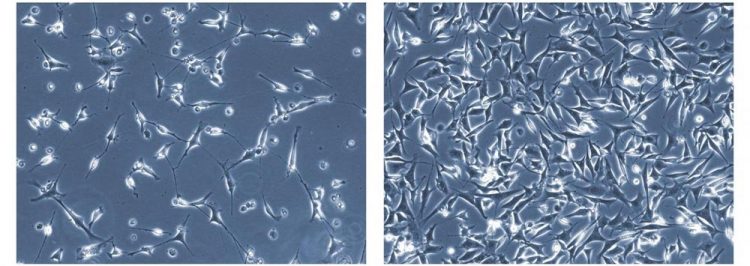Signaling pathway involving the Golgi apparatus identified in cells with Huntington's disease

Cells with Huntington's disease lack the enzyme that creates cysteine and die in environments without it (Left). Cells treated with monensin have cysteine stores and are better prepared to survive in environments with little cysteine (Right). Credit: Juan Sbodio
The findings, they say, could help scientists develop new ways to protect cells against the type of oxidative stress linked to Huntington's disease.
Details of the pathway, which involves the response from a series of proteins, are reported in the Jan. 9 issue of the Proceedings of the National Academy of Sciences.
“Normally, elevated oxidative stress is not good for cells, as it can compromise their natural protective responses,” says Bindu Paul, M.S., Ph.D., instructor of neuroscience at the Johns Hopkins University School of Medicine's Solomon H. Snyder Department of Neuroscience. “We showed that we can enhance a pathway that protects the cells with a method that resembles vaccination. By giving a lower, less potent, dose of the stressor, you can boost the cell's response so that it has a robust reaction to the real threat later on,” says Juan Sbodio, Ph.D., postdoctoral fellow at Johns Hopkins University School of Medicine's Solomon H. Snyder Department of Neuroscience.
The Golgi is best known for its role as the shipping and sorting center of the cell, shuttling proteins to their proper locations. However, the ribbon-like structure is also one of the first responders to cellular stress, and it helps to protect the cell by producing cysteine, a basic building block of the proteins that make up our bodies, including the body's natural antioxidant glutathione.
When a cell is exposed to cysteine deprivation and oxidative stress, the cell sends out the alarm to produce more cysteine to create glutathione, which combats oxidative stress by binding to and neutralizing oxidating agents. The researchers knew that a similar process is initiated by the Golgi when exposed to monensin to induce Golgi stress and wanted to explore this response further.
To better understand the effects of the drug, the scientists bathed cells in low doses of monensin, which, at high doses, is known to break apart Golgi. The researchers found that after the treatment, the proteins PERK, ATF4 and cystathionine ?-lyase (CSE) — the protein that is activated to create cysteine — appeared in elevated levels within the cell compared to nontreated cells. Previous research has linked low CSE production to Huntington's disease. Because of this, researchers believe that neurons with Huntington's disease cannot counteract dangerous free radicals or oxidants and are at risk of dying from stress.
The researchers wanted to find if there was a way to increase cysteine production in afflicted cells to protect them. The researchers gave lab-grown mouse cells that mimicked human Huntington's disease a small dose of monensin and depleted cysteine in their nutrient bath.
The cells treated with monensin grew normally for 7-9 days during the experiment, while those not treated with monensin withered away, the team reports.
“We think that the monensin treatment built up the cell's reserve of CSE and cysteine, protecting the cells against low cysteine levels,” says Paul.
The researchers also found that this stress response pathway also kick starts another pathway that creates hydrogen sulfide, a gas and key regulator for many important cellular processes.
In the future, the researchers hope to further study the pathway's role in overall cellular health.
###
Other researchers involved in this study include Solomon H. Snyder of the Johns Hopkins University School of Medicine Solomon H. Snyder Department of Neuroscience.
Funding for this research was provided by the U.S. Public Health Service (MH18501) and the CHDI Foundation.
Media Contact
All latest news from the category: Health and Medicine
This subject area encompasses research and studies in the field of human medicine.
Among the wide-ranging list of topics covered here are anesthesiology, anatomy, surgery, human genetics, hygiene and environmental medicine, internal medicine, neurology, pharmacology, physiology, urology and dental medicine.
Newest articles

Silicon Carbide Innovation Alliance to drive industrial-scale semiconductor work
Known for its ability to withstand extreme environments and high voltages, silicon carbide (SiC) is a semiconducting material made up of silicon and carbon atoms arranged into crystals that is…

New SPECT/CT technique shows impressive biomarker identification
…offers increased access for prostate cancer patients. A novel SPECT/CT acquisition method can accurately detect radiopharmaceutical biodistribution in a convenient manner for prostate cancer patients, opening the door for more…

How 3D printers can give robots a soft touch
Soft skin coverings and touch sensors have emerged as a promising feature for robots that are both safer and more intuitive for human interaction, but they are expensive and difficult…





















